Papers by Fabiola Vilaseca
Composites Part B: Engineering, 2016
Leucaena collinsii is a legume genus with interesting properties for soil recovering. This study ... more Leucaena collinsii is a legume genus with interesting properties for soil recovering. This study uses it as reinforcement in polypropylene reinforced composites. Composites from 20 to 50% w/w composites with a 6% of coupling agent (over the weight of fibre) were produced and injected. Flexural, impact and water uptake behaviour was studied. The flexural strength and stiffness increased as the reinforcement was increased. The impact strength decreased for un-notched samples, but increased for notched samples. The sample's fracture was observed by SEM. Both fibrilar and granular fibre fractures could be recognized. Regarding the water uptake, despite observing no influence on the diffusion coefficient, the maximum water uptake capacity enhanced when the Leucaena collinsii was increased.
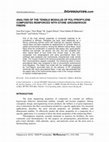
BioResources, 2012
One of the most relevant properties of composite materials to be considered is stiffness. Fibergl... more One of the most relevant properties of composite materials to be considered is stiffness. Fiberglass has been used traditionally as a fibrous reinforcing element when stiff materials are required. However, natural fibers are been exploited as replacements for synthetic fibers to satisfy environmental concerns. Among the different natural fibers, wood fibers show the combination of relatively high aspect ratio, good specific stiffness and strength, low density, low cost, and less variability than other natural fibers of such those from annual crops. In this work, composites from polypropylene and stone groundwood fibers from softwood were prepared and mechanically characterized under tensile loads. The Young's moduli of the ensuing composites were analyzed and their micromechanics aspects evaluated. The reinforcing effect of stone groundwood fibers was compared to that of conventional reinforcement such fiberglass. The Halpin-Tsai model with the modification proposed by Tsai-Paga...
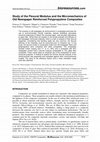
The inclusion of old newspaper as reinforcement in composites promotes the use of environmentally... more The inclusion of old newspaper as reinforcement in composites promotes the use of environmentally friendly materials, reduces landfilling, decreases chemical treatments to bleach the recycled paper, and provides alternatives to glass fiber. While there are studies on the tensile strength and stiffness of old newspaper reinforced materials, there is a lack of analysis of their flexural properties. Considering that bending loads are very common, the flexural stiffness of the materials must be examined prior to industrial use. In this study, the flexural moduli of composites made from old newspaper fibers and polypropylene were compared with other composites. The composites showed moduli ranging from 2.1 to 4.1 GPa, and a composite with 50% newspaper content had a flexural modulus comparable to 10% glass fiber composite. These values allow an industrial use of the composites for semi-structural purposes. A method to assess the intrinsic flexural modulus of the reinforcements was presen...
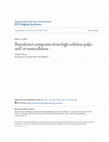
Increasingly our society seeks an economy based on renewable resources (bio-based economy) with t... more Increasingly our society seeks an economy based on renewable resources (bio-based economy) with the goal of providing materials of high value and from renewable resources. One popular renewable resource is cellulose, or forest products in general. In this study, cellulose will be combined together with bio-plastics to produce granules of thermoplastic nanobiocomposites by melt processing. The intention is to get bio-based materials of high mechanical performance that can be shaped into complex geometries using widely used industrial melt-processes such as extrusion or injection molding. WWSC is a joint research center at KTH and Chalmers CONTACT INFORMATION 1 Wallenberg Wood Science Center KTH Royal Institute of Technology Chalmers University of Technology SE-100 44 Stockholm, Sweden 2 LEPAMAP Group, Dept. of Chemical Engineering, University of Girona, ES-17003 Girona, Spain Telephone: +46 8 790 80 37 E-mail:vilaseca@kth.se Project criteria Industrial relevance and interests, pote...
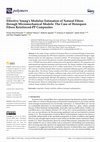
Polymers, 2021
In this study, Young’s modulus of henequen fibers was estimated through micromechanical modeling ... more In this study, Young’s modulus of henequen fibers was estimated through micromechanical modeling of polypropylene (PP)-based composites, and further corroborated through a single filament tensile test after applying a correction method. PP and henequen strands, chopped to 1 mm length, were mixed in the presence of maleic anhydride grafted polypropylene (MAPP). A 4 wt.% of MAPP showed an effective enhancement of the interfacial adhesion. The composites were mold-injected into dog-bone specimens and tensile tested. The Young’s modulus of the composites increased steadily and linearly up to 50 wt.% of fiber content from 1.5 to 6.4 GPa, corresponding to a 327% increase. Certainly, henequen fibers showed a comparable stiffening capacity of PP composites than glass fibers. The intrinsic Young’s modulus of the fibers was predicted through well established models such as Hirsch or Tsai-Pagano, yielding average values of 30.5 and 34.6 GPa, respectively. The single filament test performed to ...
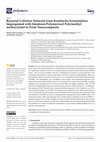
Polymers, 2021
The use of bio-based residues is one of the key indicators towards sustainable development goals.... more The use of bio-based residues is one of the key indicators towards sustainable development goals. In this work, bacterial cellulose, a residue from the fermentation of kombucha tea, was tested as a reinforcing nanofiber network in an emulsion-polymerized poly(methyl methacrylate) (PMMA) matrix. The use of the nanofiber network is facilitating the formation of nanocomposites with well-dispersed nanofibers without using organic solvents or expensive methodologies. Moreover, the bacterial cellulose network structure can serve as a template for the emulsion polymerization of PMMA. The morphology, size, crystallinity, water uptake, and mechanical properties of the kombucha bacterial cellulose (KBC) network were studied. The results showed that KBC nanofibril diameters were ranging between 20–40 nm and the KBC was highly crystalline, >90%. The 3D network was lightweight and porous material, having a density of only 0.014 g/cm3. Furthermore, the compressed KBC network had very good mech...
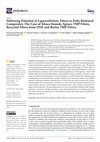
Polymers, 2021
Biocomposites are composite materials where at least the matrix or the reinforcement phases are o... more Biocomposites are composite materials where at least the matrix or the reinforcement phases are obtained from natural and renewable resources. Natural fibers for composite preparation can be obtained from annual plants, wood, recycled products, or agroforestry waste. The present work selected abaca strands, spruce fibers, recycled fibers from old newspaper, and barley fibers as raw materials to produce biocomposites, in combination with a biobased polyethylene. One very important feature in material science and for industrial applications is knowing how a material will deform under load, and this characteristic is represented by Young’s modulus. Therefore, in this work, the stiffness and deformation of the biocomposites were determined and evaluated using macromechanics and micromechanics analyses. Results were compared to those of conventional synthetic composites reinforced with glass fibers. From the micromechanics analysis, the intrinsic Young modulus of the reinforcements was o...

Journal of Applied Polymer Science, 2021
Composites in 25 kg batches were compounded of cellulose nanocrystals (CNC) and thermomechanical ... more Composites in 25 kg batches were compounded of cellulose nanocrystals (CNC) and thermomechanical pulp (TMP) and shaped into caps at industrial facilities on a pilot-plant scale. Some of the material was also injection molded into plaques to compare the effect of laboratory-scale and pilot-scale compounding of poly(ethylene-co-acrylic acid) (EAA7) and poly(caprolactone) composites reinforced with 10 wt% CNC and TMP. The materials compounded under laboratory-scale conditions showed a different morphology, improved mechanical properties, and a higher viscosity, than the materials compounded on a pilot-scale. In some cases, the rheological properties of the melts indicated the presence of a relatively strong percolating cellulosic network, and the interphase region between the cellulose and the matrix appears to be important for the mechanical performance of the composites. After the compounding on a pilot scale, both the length and width of the pulp fibers was reduced. The TMP provided better reinforcement than the CNC possibly due to the higher aspect ratio.
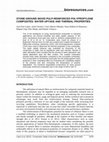
BioResources, 2012
Two of the drawbacks of using natural-based composites in industrial applications are thermal ins... more Two of the drawbacks of using natural-based composites in industrial applications are thermal instability and water uptake capacity. In this work, mechanical wood pulp was used to reinforce polypropylene at a level of 20 to 50 wt. %. Composites were mixed by means of a Brabender internal mixer for both non-coupled and coupled formulations. Differential scanning calorimetry (DSC) and thermogravimetric analysis (TGA) were used to determine the thermal properties of the composites. The water uptake behavior was evaluated by immersion of the composites in water until an equilibrium state was reached. Results of water absorption tests revealed that the amount of water absorption was clearly dependent upon the fiber content. The coupled composites showed lower water absorption compared to the uncoupled composites. The incorporation of mechanical wood pulp into the polypropylene matrix produced a clear nucleating effect by increasing the crystallinity degree of the polymer and also increasing the temperature of polymer degradation. The maximum degradation temperature for stone ground wood pulp-reinforced composites was in the range of 330 to 345 ºC.
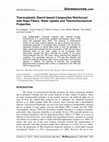
BioResources, 2013
Fully biodegradable composite materials were obtained through reinforcement of a commercially ava... more Fully biodegradable composite materials were obtained through reinforcement of a commercially available thermoplastic starch (TPS) matrix with rapeseed fibers (RSF). The influence of reinforcement content on the water sorption capacity, as well as thermal and thermomechanical properties of composites were evaluated. Even though the hydrophilic character of natural fibers tends to favor the absorption of water, results demonstrated that the incorporation of RSF did not have a significant effect on the water uptake of the composites. DSC experiments showed that fibers restricted the mobility of the starch macromolecules from the TPS matrix, hence reducing their capacity to crystallize. The viscoelastic behaviour of TPS was also affected, and reinforced materials presented lower viscous deformation and recovery capacity. In addition, the elasticity of materials was considerably diminished when increasing fiber content, as evidenced in the TMA and DMTA measurements.

Current Organic Chemistry, 2013
Biodegradable composite are composed of two or more components able to decay in a relatively shor... more Biodegradable composite are composed of two or more components able to decay in a relatively short time under specific environmental conditions, giving to non-toxic sub-products. In this context, biopolymers have become a renewable natural alternative to the traditional non-biodegradable polymers. In this work, bio-based products from starch biopolymer and rape biomass were produced. The physicochemical properties at interface of the biodegradable composites were analyzed and the intrinsic tensile strength of the rape fibers determined from biocomposites containing up to 40 wt% of reinforcement. Rape thermomechanical fibers showed good capacity to undergo efficient fiber/fiber joints, and this was evidenced by its aptitude to paper production and to the ability to reinforce biopolymers such as thermoplastic starch. The high yield thermomechanical process brought rape fibers rich in lignin at the fiber surface, and this helped to fiber individualization and dispersion into the matrix. The surface characteristics of the rape fibers allowed the anchoring to the starch matrix, by means of Van der Waals interactions and hydrogen bonding. The quality of the rape/starch interface has been analyzed and quantized in this study, and values for the interfacial shear strength () and the intrinsic strength of rape fibers () have been deduced. F t
Composites Science and Technology, 2012
ABSTRACT The present paper investigates micromechanics of hemp strands. The main objective of the... more ABSTRACT The present paper investigates micromechanics of hemp strands. The main objective of the present work has been the determination of the intrinsic strength of hemp strands. Hemp strands have been used as reinforcement of Polypropylene composites. Different percentages of hemp strands and coupling agents (MAPP) have been tested to obtain a map of the mechanical properties of that kind of composites and the effect of the components on the final properties. Mechanical properties of the different specimens have been tested using standard experimental methods and equipment. Micromechanics of the strands have been obtained using Hirsch model, Bowyer–Bader methodology and Kelly-Tyson model.
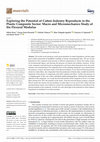
Materials
The textile sector produces yearly great quantities of cotton byproducts, and the major part is e... more The textile sector produces yearly great quantities of cotton byproducts, and the major part is either incinerated or landfilled, resulting in serious environmental risks. The use of such byproducts in the composite sector presents an attractive opportunity to valorize the residue, reduce its environmental impact, and decrease the pressure on natural and synthetic resources. In this work, composite materials based on polypropylene and dyed cotton byproducts from the textile industry were manufactured. The competitiveness of the resulting composites was evaluated from the analyses, at macro and micro scales, of the flexural modulus. It was observed that the presence of dyes in cotton fibers, also a byproduct from the production of denim items, notably favored the dispersion of the phases in comparison with other cellulose-rich fibers. Further, the presence of a coupling agent, in this case, maleic anhydride grafted polypropylene, enhanced the interfacial adhesion of the composite. As...
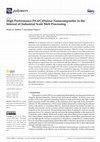
Polymers
On an industrial scale, it is a challenge to achieve cellulose based nanocomposites due to disper... more On an industrial scale, it is a challenge to achieve cellulose based nanocomposites due to dispersion issues and high process temperatures sensitivity. The current study describes methods to develop mechanically strong and thermally stable polyamide 6 (PA 6) and cellulose nanofibers (CNF) composites capable of tolerating high processing temperatures. With PA 6 being a very technical polymer matrix to be reinforced with CNF, good dispersion can be achieved with a high speed kinetic mixer and also shield the CNF from excess thermal degradation by implementing extremely short processing time. This paper presents an industrially feasible method to produce PA 6/CNF nanocomposites with high CNF composition processed by a high speed kinetic mixer (GELIMAT®) followed by compression molding to obtain a homogenous and thermally stable nanocomposites aimed at high performance applications. PA 6 was reinforced with three different wt % formulations (5, 15 and 25 wt %) of cellulose nanofibers. T...
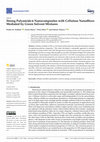
Nanomaterials
Cellulose nanofiber (CNF) as a bio-based reinforcement has attracted tremendous interests in engi... more Cellulose nanofiber (CNF) as a bio-based reinforcement has attracted tremendous interests in engineering polymer composites. This study developed a sustainable approach to reinforce polyamide-6 or nylon-6 (PA6) with CNFs through solvent casting in formic acid/water mixtures. The methodology provides an energy-efficient pathway towards well-dispersed high-CNF content PA6 biocomposites. Nanocomposite formulations up to 50 wt.% of CNFs were prepared, and excellent improvements in the tensile properties were observed, with an increase in the elastic modulus from 1.5 to 4.2 GPa, and in the tensile strength from 46.3 to 124 MPa. The experimental tensile values were compared with the analytical values obtained by micromechanical models. Fractured surfaces were observed using scanning electron microscopy to examine the interface morphology. FTIR revealed strong hydrogen bonding at the interface, and the thermal parameters were determined using TGA and DSC, where the nanocomposites’ crystall...
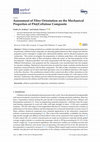
Applied Sciences
Cellulose is being considered as a suitable renewable reinforcement for materials production. In ... more Cellulose is being considered as a suitable renewable reinforcement for materials production. In particular, cellulose based composites are attracting global interest for their unique and intrinsic properties such as strength to weight ratio, dimensional stability and low thermal expansion and contraction. This article investigates the preparation of cellulose pulp fibers with polyamide-6 (PA6) polymer and the effect of fiber orientation within the matrix on the final properties of the biocomposite. Cellulose pulp fibers were melt compounded with PA6 using a thermo-kinetic mixer. Different formulations were prepared and the compounds were manufactured into test samples by injection molding. Mechanical characterization revealed that elastic modulus and the flexural properties increased linearly with the fiber composition. The effect of fiber orientation was examined from square samples out of which individual specimens were cut at different directions with respect to the flow directi...
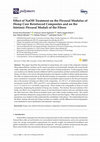
Polymers
This paper describes the potential of using hemp core waste in the composite industry. These lign... more This paper describes the potential of using hemp core waste in the composite industry. These lignocellulosic residues can be used to produce environmentally friendly and economically viable composites and improve the overall value chain of hemp production. To this purpose, hemp core residues were alkaline treated at different NaOH concentrations and then mechanically defibrated. Hemp core fibers were mixed with polypropylene and injection molded to obtain testing specimens. The effect of sodium hydroxide on the flexural modulus of composites was studied from macro and micro mechanical viewpoints. Results showed remarkable improvements in the flexural modulus due to the presence of hemp core fibers in the composites. At a 50 wt % of reinforcement content, increments around 239%, 250% and 257% were obtained for composites containing fibers treated at a 5, 7.5 and 10 wt % of NaOH, respectively. These results were comparable to those of wood composites, displaying the potential of hemp ...
Advanced Materials Technologies











Uploads
Papers by Fabiola Vilaseca